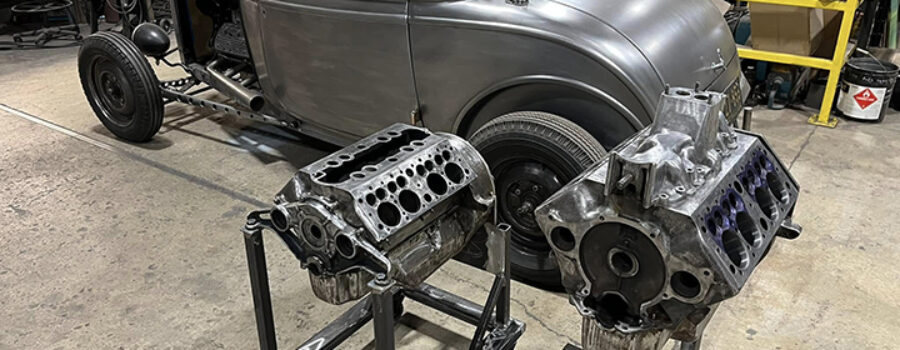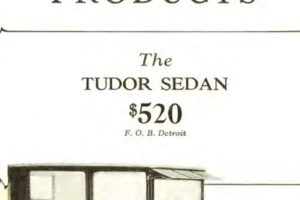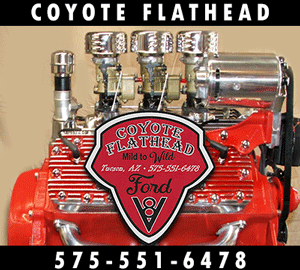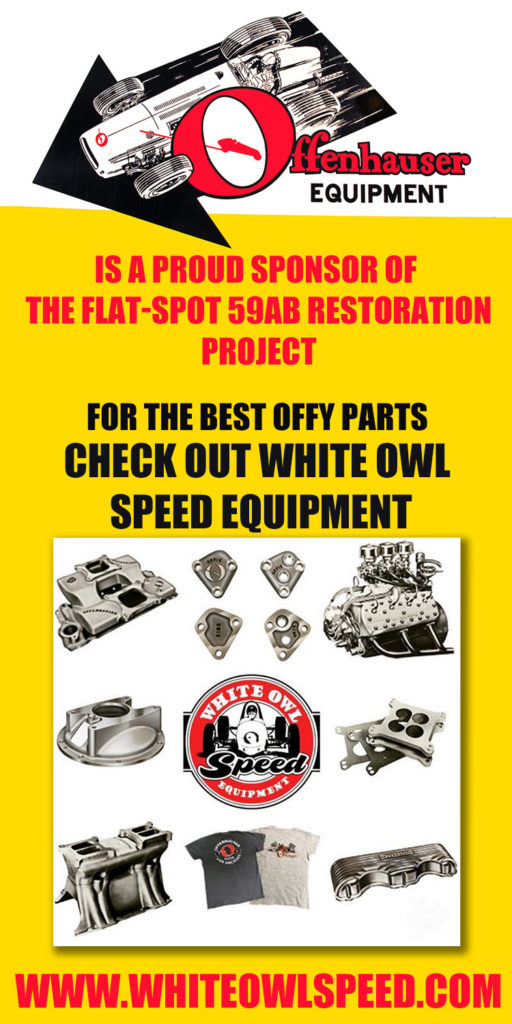We have done our best to create a page that should help many of you ID your Flathead Ford V8. This page is a work in progress. So, let’s get into it. A little-known fact is that Ford didn’t put Vin Numbers on their Flathead v8 engines. In fact, from 1932-1953 ford didn’t have Vin Numbers. Vin’s were not a thing until the 1960s. Long after the Flathead style block was retired. What ford used was a cycle of serial numbers. But often the number was stamped into the transmission. But keep in mind your vehicle may have had 1,2,3 transmissions in its life. So, these numbers don’t mean anything when it comes to your engine. So don’t assume anything just yet.
Another common mistake we make is that owners will often try and date their engine based on the casting number on the head. Unless you were the original owner of that engine which in this day and age is getting to be less and less likely. You must know that heads were often replaced due to corrosion, warping, and just being worn out. When you took your engine into a shop, they would grab the first set of heads they had on the shelf. So, you may have driven in with EAC heads… But you may have driven out with 59AB heads. It was the wild west and nothing on your engine can be trusted.
The last little place many new builders and hobbyist get things wrong is by reading the numbers stamped into the top deck of your block. One thing many people don’t know is that Ford during most of the Flathead Era had something called the Dealer Exchange program. This was a program that relieved much of the in-house mechanic work by just replacing worn and damaged parts. Including engines. If you came in to a Ford dealer with an engine that say… had blown rings. The dealer would swap out the engine for a motor they had on the shelf. Your engine would go back to Ford and be rebuilt by FoMoCo to be given to the next Dealer’s customer. This is why I find it so cringe when someone says they have the original engine in their old ford. Because the likelihood of that happening is so SO small. But often if you took your engine into any Ford Dealer or even a non-brand name mechanic to be rebuilt, they would stamp numbers into the top deck of the engine. The trouble with using these numbers is you don’t know who may have stamped them. Often these days your engine has likely been rebuilt at least 2-3 times. That means each time it went in, a mechanic may have stamped all manner of numbers into the top deck based on their own systems. Making this method of ID impossible to confirm. No matter what the smart ass on the HAMB says.
In this post we will go over some of the most common landmarks on different generations of Flathead blocks, in order to help you narrow down what you may have. If you are looking for more information about the accessories you may have on your engine. Check out this blog post, we did about “IDing Your Flathead Ford”
Sources used to create this page include Zac Parks (Wired Customs LLC), Motor City Garage, and V8-60 Ford’s Little Powerhouse and notes gathered from H&H Flatheads
If your more looking to ID some of the external accessories on your Flathead Ford v8 then click the button above.
List of Blocks Known & Their Years
1932-Model 18
1933-Model 40
1934-Model 40A
1935-Model 48
1936-Model 68
1937-Model 78
1938-Model 81A
1939-Ford Model 91A
1939-Mercury Model 99A
1940-1942-Ford 01A, 11A, 21A
1940-1942-Mercury 09A, 19A
In 1946-1948 Fords official designation got more confusing
1946-1948 Ford had 69A, 79A and 89A all with 59 cast on the bell-housing. (59 variations include – 59, 59A, 59AB, 59L, 59V, 59X, 59Y, 59Z) with the plan 59 and 59A being the most common.
1946-1948 Mercury 29A, 59A, C69A
1948 Ford 98BA commonly known as 8RT
1950-1953 Ford 8BA also designated 8RT
1949-1953 Mercury 8CM
1932 Flathead V8 Blocks
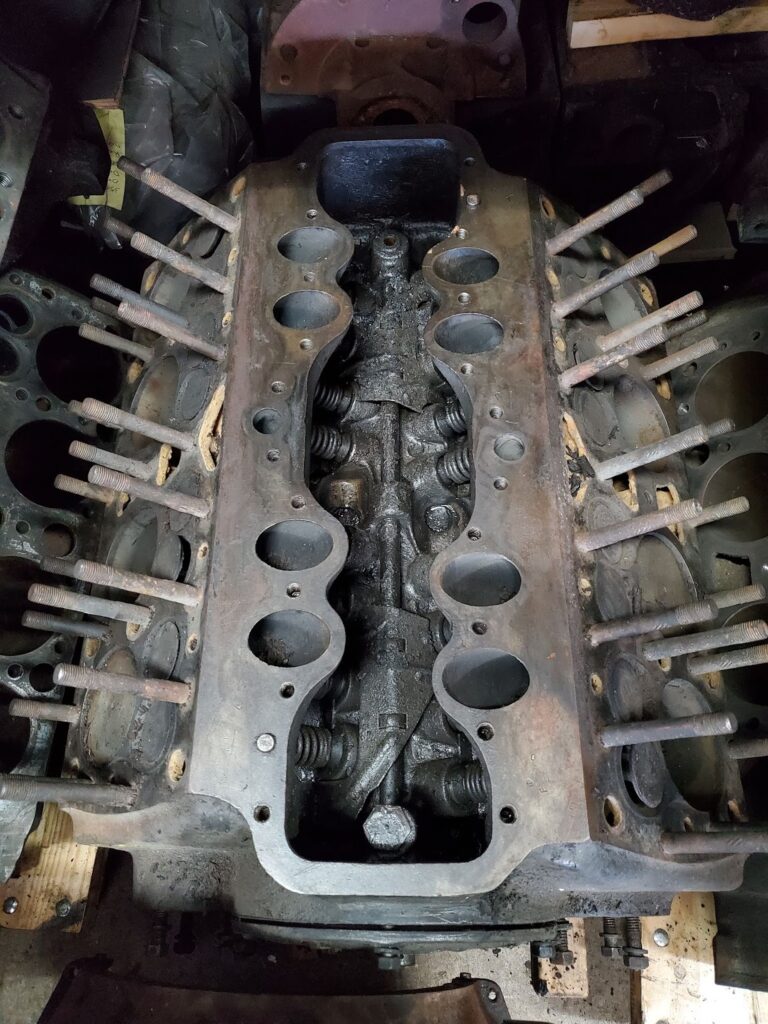
1933-1936.5 Flathead V8 Blocks
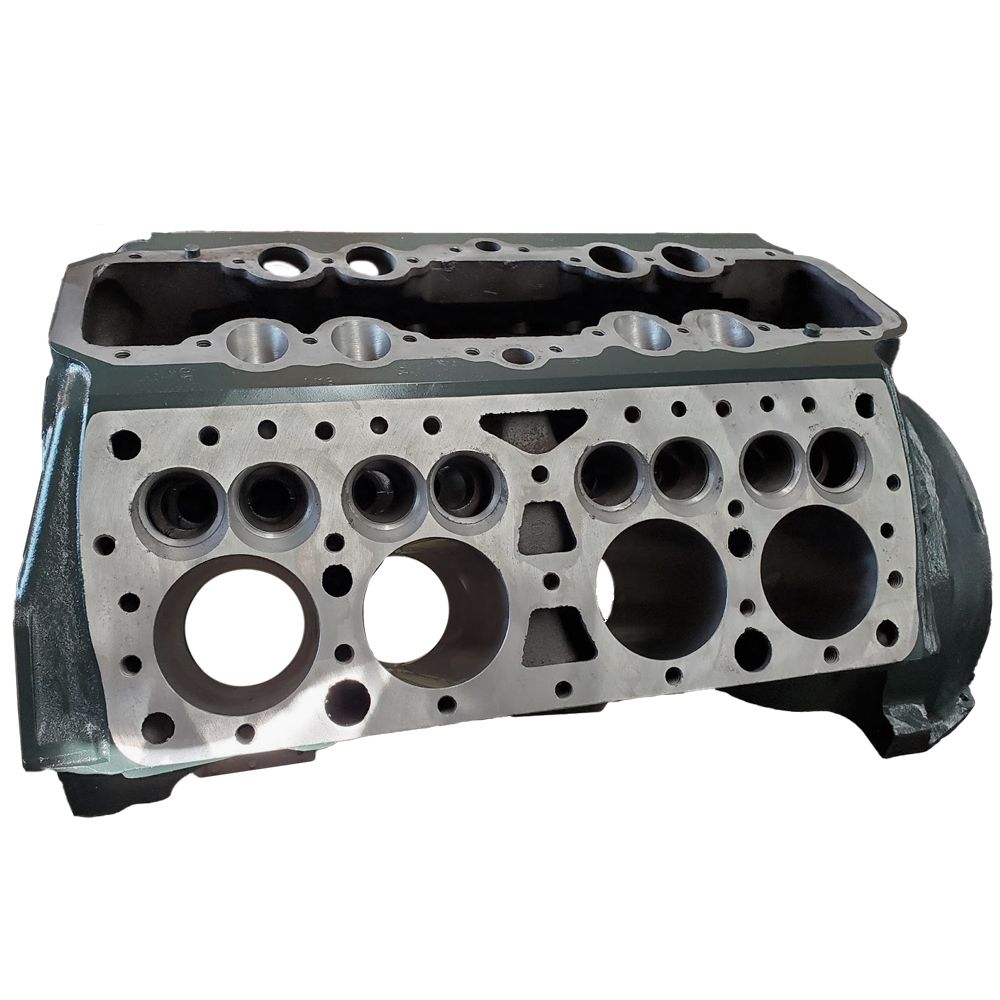
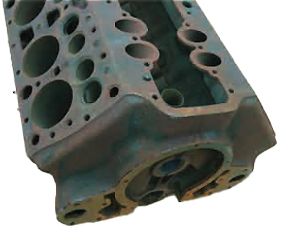
Better known as the 21 stud Flathead these engines where easily ID’s by their 3 studs running down the center of the head. The 1936 was the first year that the Insert Babbitt bearings were introduced. Making it pretty easy to see if you have a 1936 or 36.5. The easiest way to spot the difference is to
look for the insert tang in the main bearing cap. Note the 1936.5 also have a freeze plugs in this pan rail.
1935 Flathead V8 Blocks
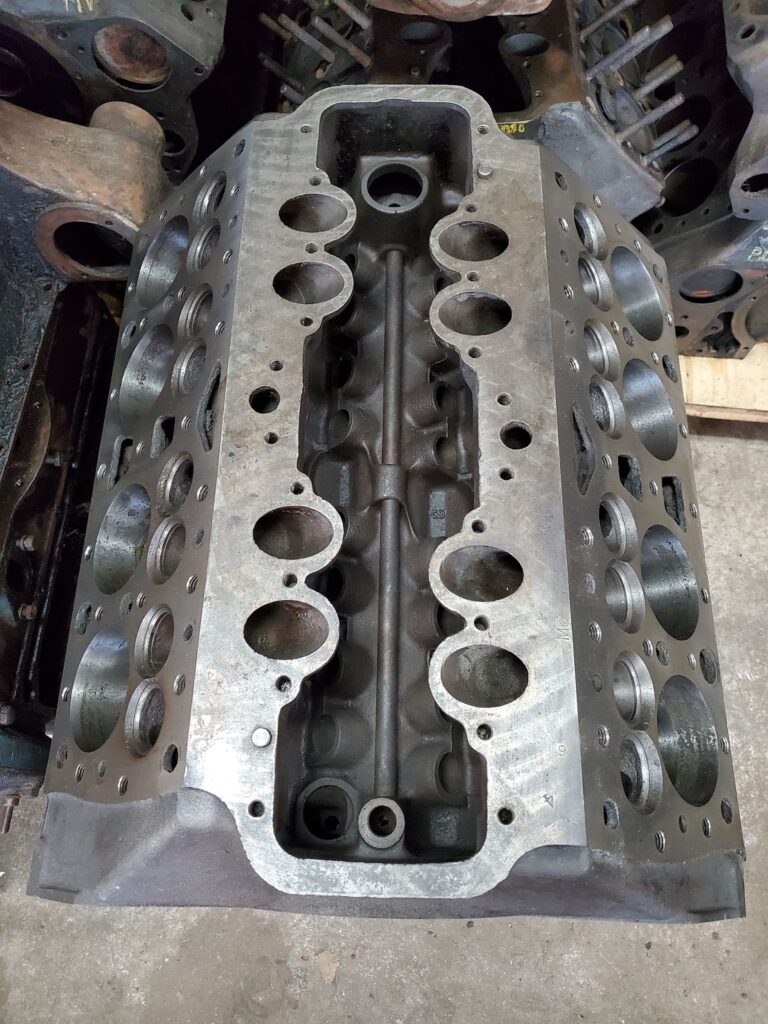
1937 Flathead V8 Blocks
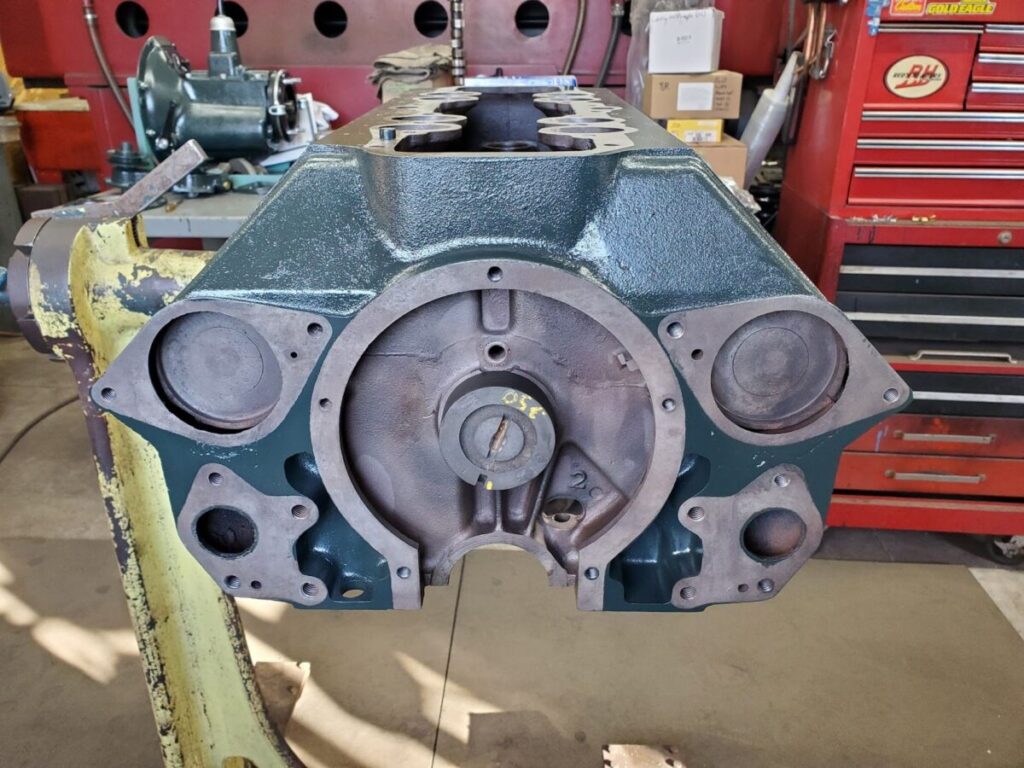
1938 another significant change was 24 studs used to hold down each head. Easiest way to check for 24 studs is count the studs in the center with the center coolant passages like the earlier motors, here you see two studs.
1937 Flathead V860 Blocks
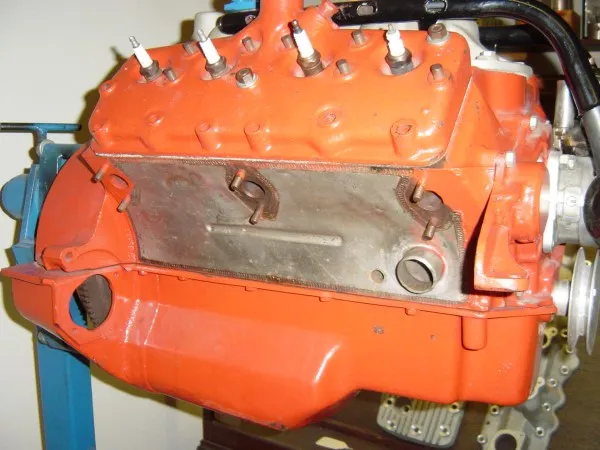
The refined V8-60 of 1937, above, was very much a miniaturized version of the original Flathead Ford V8 introduced in 1932, with its displacement scaled down from 221 cubic inches to a dinky 136 cubic inches. The bore was a petite 2.60 inches; the stroke 3.20 inches, and the rated output was 60 hp, compared to 85 hp for the senior ’37 V8. Below you can see the size difference between the two blocks. The v860 on the left and the fulls size V8 on the right.
Another distinctive V8-60 feature, in early production anyway, was an innovation that became known as the “tinside.” The cooling jacket on each bank was closed out with a sheet metal plate electrically welded in place (above). Many thousands of these V8-60 blocks were produced before Ford reverted to a conventional casting, and they are not terribly uncommon on the collector car scene today. (Some unknown number of experimental blocks for the big Ford V8 were also manufactured this way.)
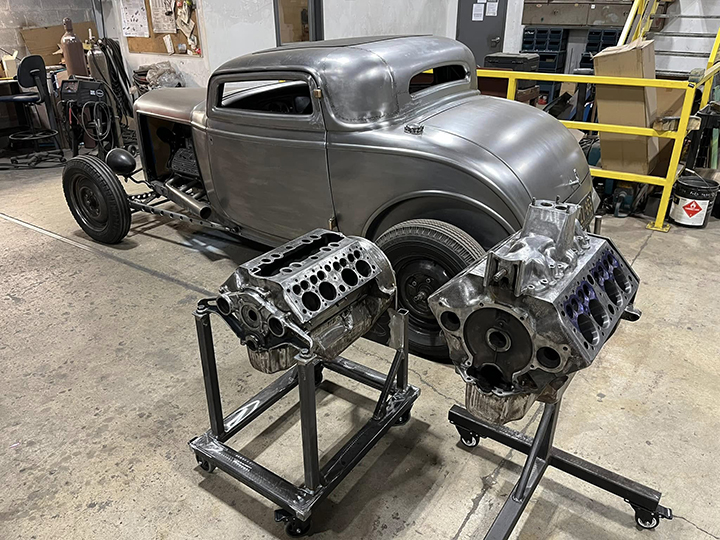
1938-39 Flathead V860 Blocks
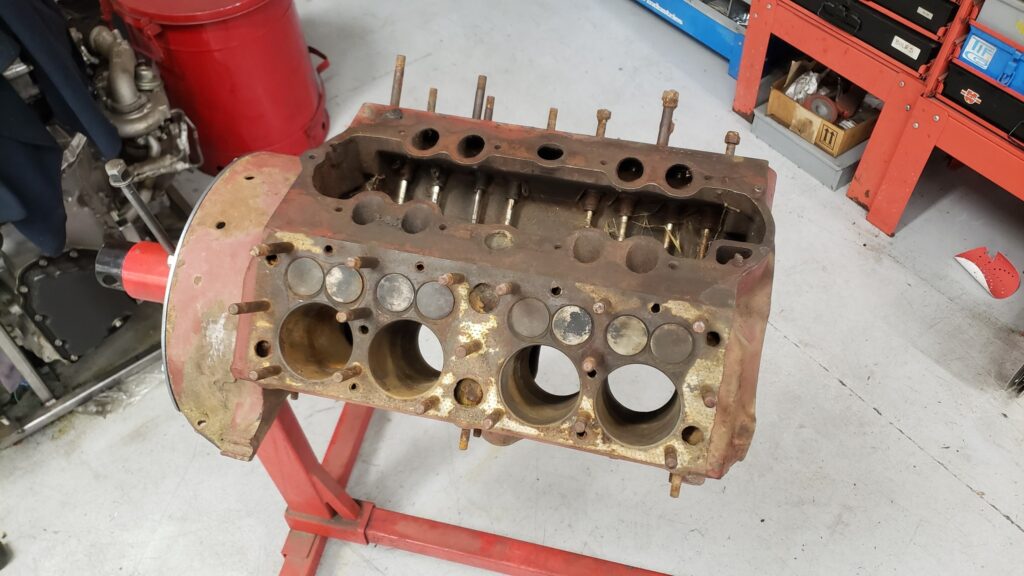
These are all cast blocks which are easy to spot with the breather hole being on the bell housing. The intake for the engine is also easy to spot because it has no breather. Unlike the 1940 model.
1940 Flathead V860 Blocks

Ford buyers were attracted to the V8-60’s fuel economy, and sales were brisk. But sales quickly trailed off as the word got out about the engine’s poor acceleration and due to low power had to work twice as hard thus lower it’s touted fuel economy. The V8-60 was discontinued in the USA after 1940. The easiest way to tell the 1940 version of the V8-60 is the fact it has no breather hole on the bell housing.
Bonus fact: Below you can see a very rare 1940 Pan (Left) doesn’t have a road draft breather. Where the earlier 1937-39 pans (right) do. This is also a great way to spot the 1940.

Below is a 1940 block. Notice how the block does not have a breather for the road draft tube in the pan.
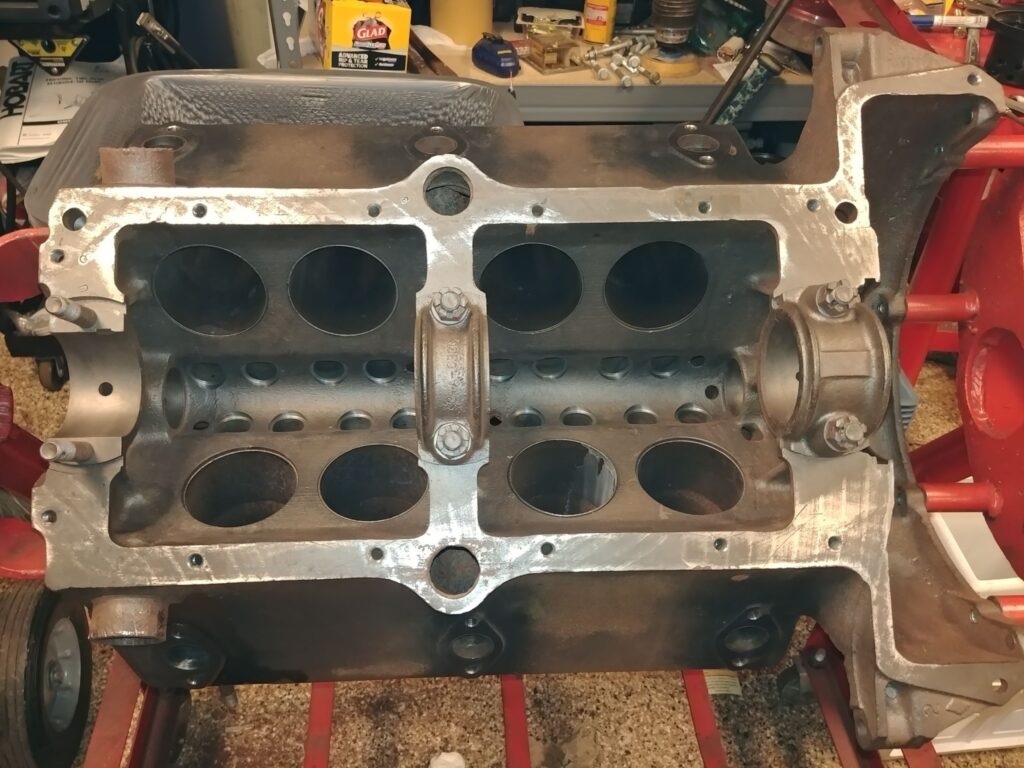
Below is a 1939 block. Notice how the block does have a breather for the road draft tube in the pan located just to the right of the crank baring.
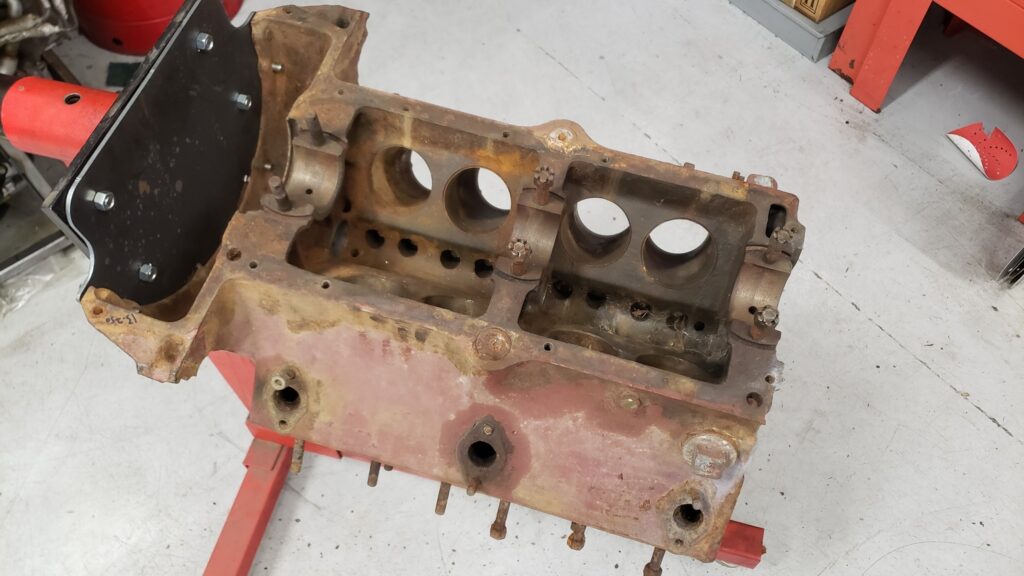
One novel V8-60 feature was the front engine support casting, which doubled as the timing cover and mount for the ignition distributor and twin water pumps. The two Ford V8s, big and little, are similar enough in general appearance that they are sometimes confused by the casual observer. One foolproof way to identify the V8-60: There are only 17 head bolts per cylinder bank, while the standard V8 employs 21 or 24 fasteners per side.
1938-1939 Flathead V8 Blocks
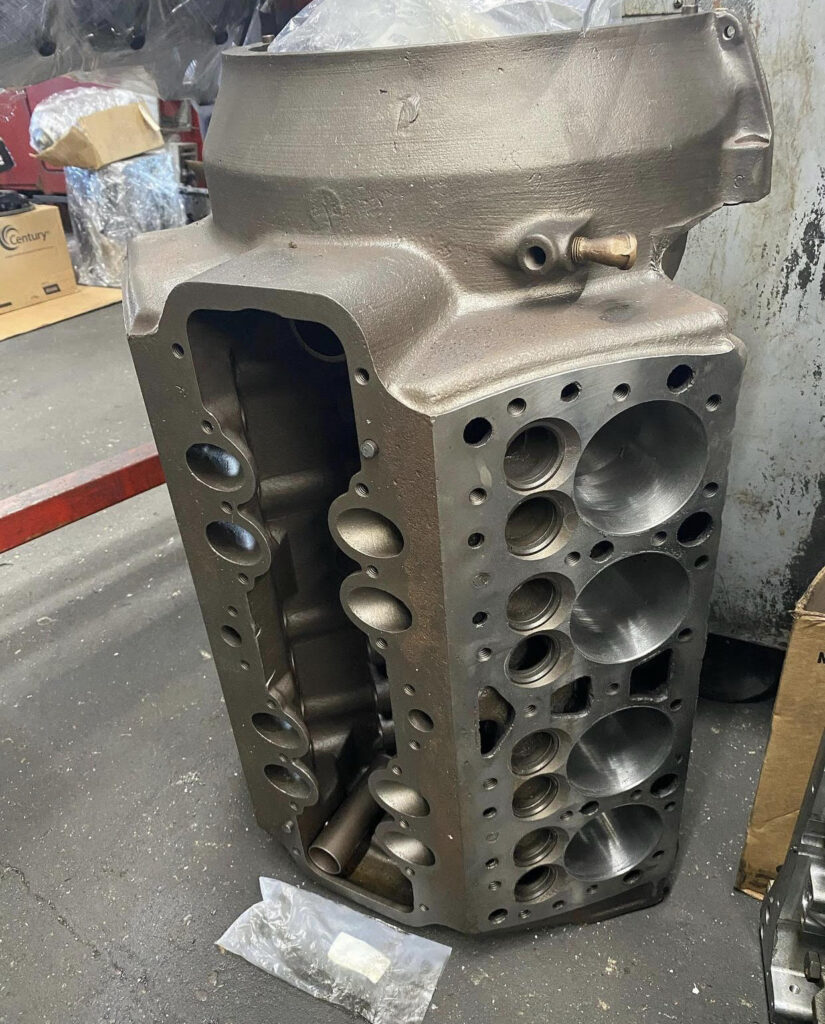
1939 Flathead 99A Blocks
The first picture below is the 99A which is a 1939 Mercury block, it has a round passage in the center of the coolant passages. The 99A is one of the few early motors with an actual designator on the block, in the second picture below you’ll see “99” stamped on the intake surface.

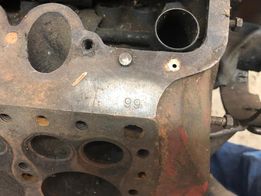
The 1940 Mercury engine is very similar to the Ford in that it has 24 studs, a cast-in bellhousing, and a Raised intake deck. However, it has a slightly larger bore, affording 239 ci compared to 221 ci, and therefore 95 hp compared to the Ford’s 85
1941-1942 Flathead V8 Blocks

The 1941-1942 Blocks have a badge shaped center outlet and only have 2 center studs. One of their most common ID points is the fact they have a raised intake deck. Which makes them quite easy to spot.
1943-1945 Flathead V8 Blocks

These engines can be ID’s by their duel center badge shaped outlets. Unlike the 1941-1942 these blocks have a smooth top deck where the intake mounts.
1946-1948 69A Series Flathead V8 Blocks

1947-1948 C69 Series Flathead V8 Blocks

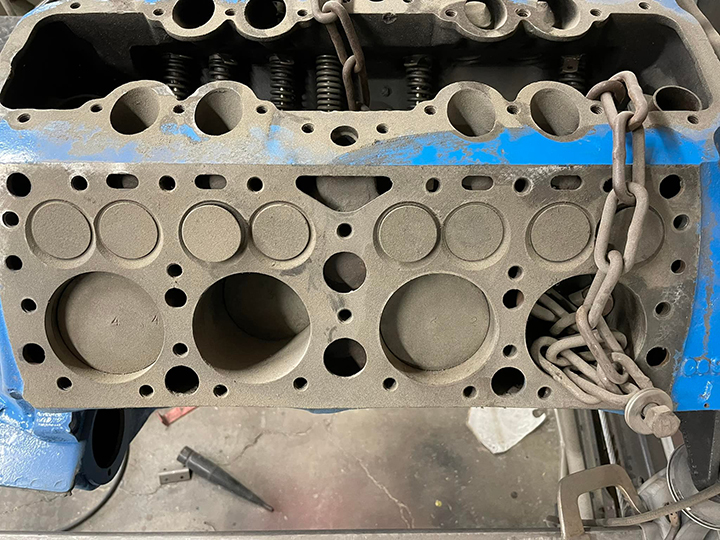
C69A is Canadian 1947/8 only. It came with 8BA valve assys & 8BA con rods & bearings, crank therefore also same as 8BA with 2 oil hole journals. Mains had bolts not studs. Better casting than the USA version, crank pins with two oil holes, separate insert type rod bearings. The valves are a different distance from cylinders so care is needed where cylinder head interchangeability is concerned.
1946-1948 59 Series Flathead V8 Blocks

1946-1948 Ford built one of the most recognizable Flathead blocks, the 59 series. I call it the 59 series because there were so many different designations in a 3 year window. They are easily identified with the “59” cast into the integrated bell housing, but a lot of people fail to notice the changes in the center coolant passages that are now circular in the middle and bottom, take a note of the top coolant passage in the center, this changes in the next model . A few versions to note are the 59L 59X 59Y and the 59Z. 59L was in some cased a factory relieved block and some of the 59Zs were also relieved. But that was not always the case as I have personally got a 59L that was not relieved much to my dismay. These were the only blocks to come from the factory as relieved. Relieving became a common performance upgrade and many different blocks today can be found relieved. Let it be known that the 59Z is blurry in the Archives and some blocks were not relieved depending on location.

The 59L was a block that was primarily used in large commercial vehicles like buses and large trucks. These blocks are harder then the standard 59 Series blocks and thus less prone to cracking and a little more durable then the standard 59 blocks.

The 59X was a block that was Commissioned by the US Gov and was specifically used in there trucks and non-tank attack vehicles like convoy trucks and transport vehicles. These blocks are made of a mix of metals that are much harder than other 59 blocks and thus less prone to cracking.
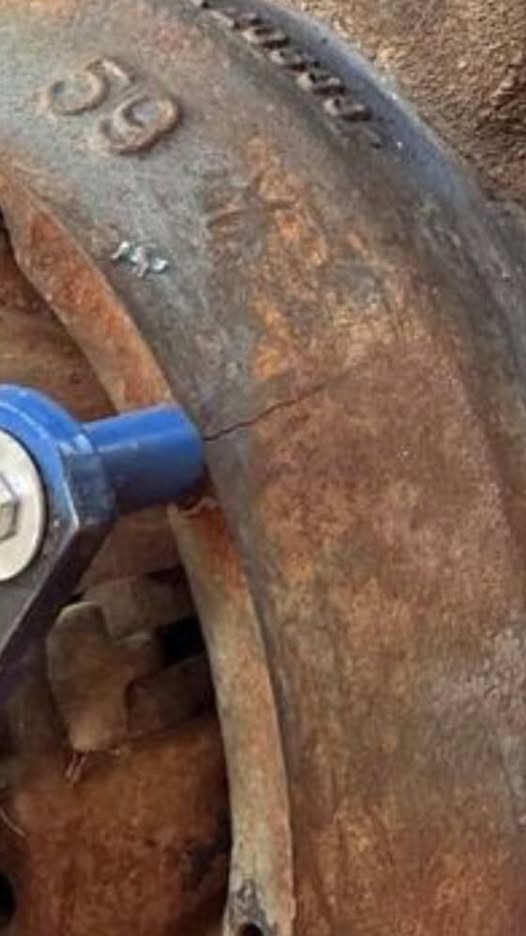
The 59Y was a block that was used mostly in industrial use items for the US Government. The blocks where used in things like generators, water pumps, and welding systems.

The 59Z Block was used we think in attack vehicles things like light infantry and gunner vehicles for the US military. The blocks are the hardest of the 59 Series blocks and thus the least likely to crack and the hardest to machine. There have been complaints that shops have gone threw a full set of bits trying to get these engines milled.
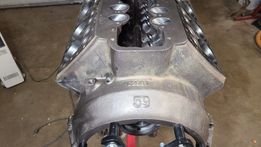
1949-1953 Flathead V8 Blocks
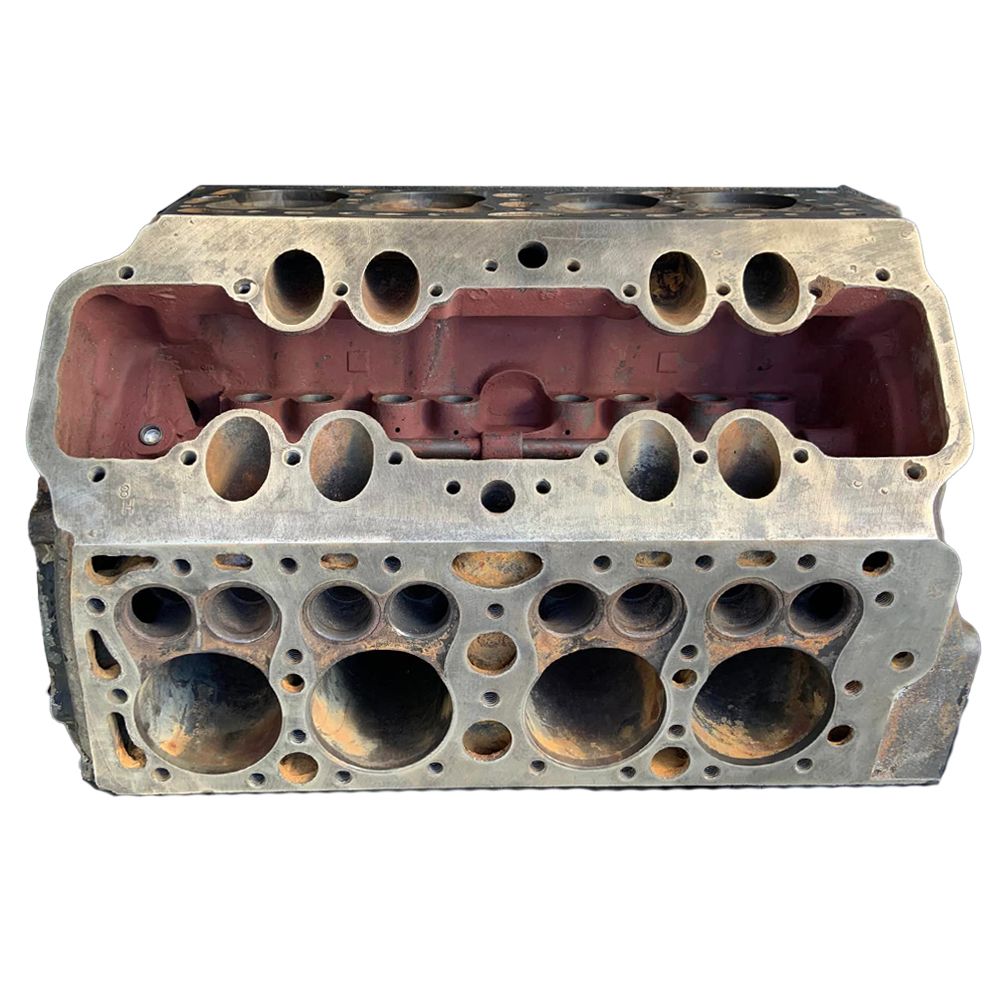
The 8ba block is easiest to identify by the fact it doesn’t have a cast bell housing. The bell is a separate section from the block. These engines also have duel round water ports in the center of the block. This block as you can see has been machined and reworked. It features a drilled tappets for adjustable valves and also I believe this block has been revealed. Which is a process where metal is removed around the valves and the flow is increased. That is not stock.
Unexpected Plot Twist: Flathead V8’s From Post 1954-1993
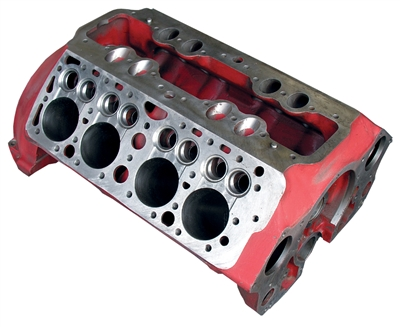

The Flathead would continue to be made over seas ending production in 1993. Many have made there way over to the US through companies like Socal Sacramento (Closed during the Pandemic) and H&H Flatheads (Still active). Those engines where known as the French Blocks and they’re hands down one of the best engineered blocks you can get. If you can find one. $$$. The block also commonly has to have the bell housing milled to fit against a ford firewall. As you can see by the photo the French blocks have a larger oil gov. cast into the housing.
HOW NOT TO ID YOUR BLOCK
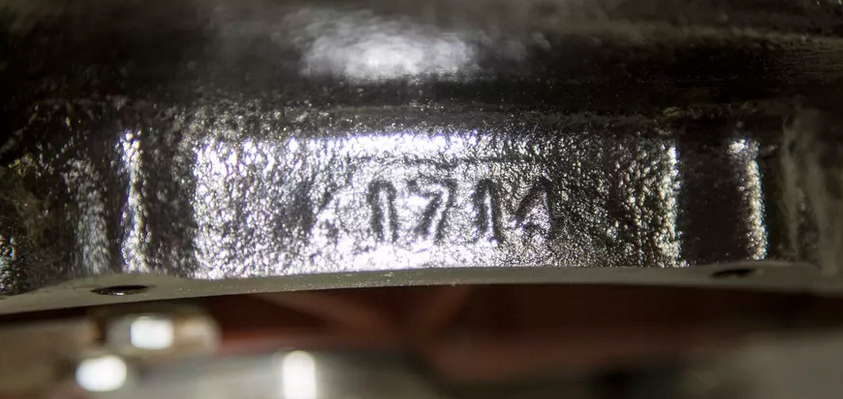
The number on the bell housing is always the rookie go to for asking others to ID the block. I mean it makes sense. But that number was not a serial number unique to your Flathead. It is actually a casting lot number. Used to check the batches of each lot, but was a repeating number. So it can’t be used to ID the engine. In fact most of the numbers on the block are useless. The one your commonly want to look for is the one stamped into the top deck of the engine. There should be stamp near the front on the driver side. That is the closest to a solid ID your honestly going to get.
Also keep in mind that Ford dealers and other mechanics would stamp additional info into that number when they would do a rebuild. Making this difficult to figure out when their seems to be to many numbers. For example check out the image below. You can see the stamped number next to the intake port if you look really close to the right of it.
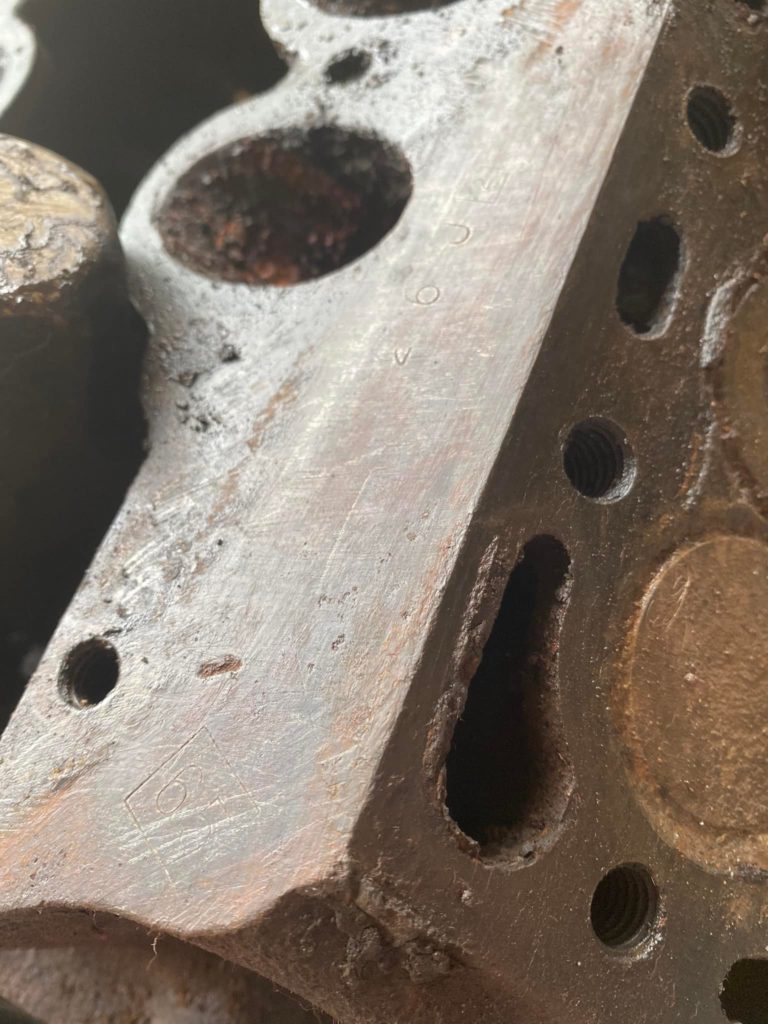

Decode the engine serial number. Telusplanet’s Ford Flathead V-8 Engine Identification Chart lists 11A as the code for a 1941 V-8. These codes must be referenced to the chart on this site (see References). Engine numbers preceded with a “C” are Canadian manufactured. On 1948 and later flatheads, Flathead Drag decodes the first letter as the month, the following one or two numbers as the day and final letter as the last digit of the year. G20 B is an engine manufactured on Jan. 20, 1952.
The letter code is as follows: M=0, G=1, B=2, L=3, A=4, C=5, K=6, H=7, T=8, R=9, S=10, E=11, F=12.
GETTING INTO IT
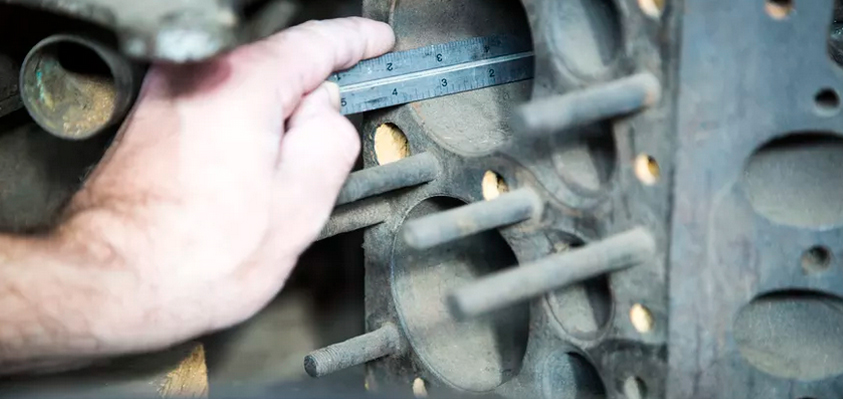
Measure the stroke. On the 221-, 239- and 255-cubic-inch engine, which cannot be differentiated by any other method, measuring the stroke identifies the engine as they both have different stroke measurements. Remove one of the cylinder heads and crank the engine until one of the pistons is at dead-bottom. Measure the distance between the top of the piston and the top of the cylinder wall with a fine measurement machinist’s ruler. The stroke on the 221 measures 3.75 inches, the 239 is 3.1875 inches and the 255 stroke measures 4 inches.
| Model Year | Make and Engine | Passenger Car Model (note a) | First Serial Number (See note B below) |
| 1932 | V8 | 18 | 18- 001 to 18-203,126 |
| 1933 | V8 | 40 | 18- 203,127 to 18-457,477 |
| 1934 | V8 | 40 | 18- 457,478 to 18-1,234,356 |
| 1935 | V8 | 48 | 18-1,234,357 to 18-2,207,110 |
| 1936 | Ford V8 Linc-Zephyr V12 | 68 901 | 18-2,207,111 to 18-3,331,856 H-1 to H-15,549 |
| 1937 | Ford V8 – 60hpFord V8 – 85hp Linc-Zephyr V12 | 74 78 HB | 54- 6,602 to 54- 358,334 18-3,331,857 to 18-4,186,446 H-15,550 to H-45,529 |
| 1938 | Ford V8 – 60hp Ford V8 – 85hp Linc-Zephyr V12 | 82A 81A 86H | 54- 358,335 18-4,186,447 to 18-4,661,000 (f) H-45,530 to H-64,640 |
| 1939 | Ford V8 – 60hp Ford V8 – 85hp Mercury V8 – 90hp Linc-Zephyr V12 | 922A 91A 99A 96H | Continued from 1938 to 54-506,500 (d) 18-4,661,001 to 18-5,210,700 (e) 99-001 to 99-101,700 H-64,641 to H-85,640 |
| 1940 | Ford V8 – 60hp Ford V8 – 85hp Mercury V8 – 90hp Linc-Zephyr V12 | 022A 01A 09A 06H | 54-0,506,501 to end (g) 18-5,210,701 to 18-5,896,294 99A-101,701 to 99A-257,100 H-85,641 to H-107,687 |
| 1941 | Ford V8 – 90hp Ford 6 – 90hp Mercury V8 – 95hp Linc-Zephyr V12 | 11A 1GA 19A 16H | 18-5,896,295 to 18-6,769,035 1GA-000,001 to 1GA-034,800 99A-257,101 to 99A-466,700 H-107,688 to H-129,690 |
| 1942 | Ford V8 – 90hp Ford 6 – 90hp Mercury V8 – 100hp Linc-Zephyr V12 | 21A 2GA 29A 26H | 18-6,769,036 to 18-6,925,898 1GA-034,801 to 1GA-227,523 99A-466,701 to 99A- H-129,691 to H-136,254 |
| 1946 | Ford V8 – 100hp Ford 6 – 90hp Mercury V8 – 100hp Lincoln V12 | 69A 6GA 69M 66H | 99A-650,280 to 99A-1,412,709 1GA-227,524 to 1GA- 326,417 99A-650,280 to 99A-1,412,709 H-136,255 to H-152,839 (k) |
| 1947 | Ford V8 – 100hp Mercury V8 – 100hp Ford 6 – 90hp (G) Ford 6 – 90hp (H) Lincoln V12 | 79A 79M 7GA —- 76H | 799A-1,412,708 to 799A-2,071,117 (i) 799A-1,412,708 to 799A-2,071,117 71GA- 326,418 to 71GA- 414,366 77HA- 0,512 to 77HA- 9,038 (c) 7H-152,840 to 7H-174,289 |
| 1948 | Ford V8 – 100hp Ford 6 – 90hp Mercury V8 – 100hp Lincoln V12 | 89A 8GA 89M | 899A-2,071,118 to 899A-2,374,315 87HA- 0,536 to 87HA- 073,901 (i) 899A-2,005,028 to 899A-2,374,315 8H-174,290 to 8H- |
| 1949 | Ford V8 – 100hp Ford 6 – 95hp Mercury V8 – 110hp | 8BA 8HA 9CM | 98BA-101 98HA-101 9CM -101 |
| 1950 | Ford V8 – 100hp Ford 6 – 95hp Mercury V8 – | 0BA 0HA 0CM | B0-100,001 (J) H0-100,001 50-100,001M |
| 1951 | Ford V8 – 100hp Ford 6 – 95hp Mercury V8 – | 1BA 1HA 1CM | B1-100,001 (J) H1-100,001 51-100,001M |
| 1952 | Ford V8 – 110hp Ford 6 – 101hp Mercury V8 – | B2 A2 (All) | A2-100,001 (J) B2-100,001 52-100,001M |
| 1953 | Ford V8 – 110hp Ford 6 – 101hp Mercury V8 – | B3 A3 (All) | A3-100,001 (J) B3-100,001 53- 5,001H |



